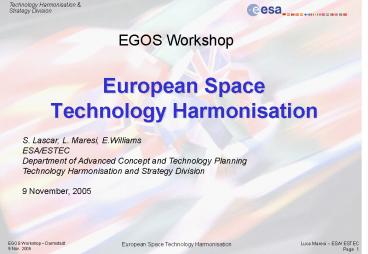European Space Technology Harmonisation - PowerPoint PPT Presentation
1 / 15
Title:
European Space Technology Harmonisation
Description:
Technology Harmonisation & Strategy Division. EGOS Workshop ... dation. Technology. Observatory. Technology. Monitoring. ESA. R&D. Contracts. Dossier 0 ... – PowerPoint PPT presentation
Number of Views:72
Avg rating:3.0/5.0
Title: European Space Technology Harmonisation
1
European Space Technology Harmonisation
EGOS Workshop
S. Lascar, L. Maresi, E.Williams ESA/ESTEC
Department of Advanced Concept and Technology
Planning Technology Harmonisation and Strategy
Division 9 November, 2005
2
Presentation Outline
- Mandate
- Main Objectives
- European Process
- Principles
- How it works
- Subjects Harmonised to date
- Harmonisation planned for 2006
- Conclusions
3
The Mandate of Harmonisation(Excerpt out
Ministerial Resolution, Ref. ESA/C_M/CLIV/Res.1)
- The Ministerial Council Meeting, in Edinburgh,
on November 2001, invited the ESA Director
General and the Member States, together with the
other players() in the space sector, to
- Pursue the programmatic coordination and
harmonisation of technology programmes in Europe
and prepare the European Space Technology Master
Plan (ESTMP) - Define roadmaps and harmonised implementation
schemes for the development of critical
technologies, involving industrial funding as
appropriate - ()including EC
4
European Space Technology Harmonisation
- Main objectives
- Fill strategic gaps and Minimize unwanted
duplications, - Consolidate European Strategic capabilities,
- Achieve a coordinated and committed European
Space Technology Policy, - Ensure continuity and coherence between
Technology and Industrial Policies,
5
European Space Technology Harmonisation
- Principles
- Optimise public fund investments in Space
Technology and determine the RD priorities to
satisfy European space ambitions, commensurate
with the available resources, - Play a pro-active role in creating a balanced
industrial landscape by specialising skills, and
strengthening industrial cooperation, considering
appropriate geographical distribution while
maintaining a competitive environment and
ensuring a fair role to each player, irrespective
to presence of national space programme and
without discrimination for non-EU Member States, - Promote long-term agreements based on
competitiveness, - Respect role of Technology Innovation and
advanced Research, - Consult actively Industry and National
Delegations in definition of Technology
programmes, - Stakeholders contribute on a voluntary basis,
- Implement in all ESA Technology programmes and in
ESA programmes containing Technology development,
the Roadmaps and conclusions stemming from the
Technology Harmonisation process, - Maximise utilisation of European Technology in
ESA programmes with due consideration to
programme risk, - Promote the implementation of the Harmonisation
recommendations in national and commercial
programmes.
6
How it works
- Participants are ESA Member States and their
delegations, the European Commission, European
Industries and Eurospace and ESA directorates - Space Technologies are addressed one at a time
- The Harmonisation is based on 2 meetings
- Technology Mapping
- Technology Roadmap
- Complete proceedings are issued after meetings
including conclusions
Selection of technology to harmonise (for the
year)
Technical Dossier
Mapping Meeting
(open)
Proposed Road-map
Road-map Meeting
(ESA, Member States, EC)
Conclusions Proceedings
Follow-up and Status Report
7
Our Interfaces
Member States/ National Agencies
Non-European Countries (Agencies/Industry)
EC
Eurospace
EUI-AH
D/TEC
ESA Industrial/Procurement Policy (D/RES)
Space Industry
Academic Sector
ESA Programme Directorates
8
A Fully Operational process
9
The Pilot Phase 2000/2001
- In 2000
- Electrical Propulsion
- Solar Cells
- SAR
- In 2001
- Cryogenics
- AOCS Sensors
- Robotic
10
Technologies Harmonised up to 2004
- Solar Arrays Drive Mechanisms
- Deployable Booms
- Upper stage propulsion
- Optical communication for space
- Microwave Power Breakdown Modelling and
Characterisation - Antenna Reflectors
- Hold-on and Separation Systems
- Critical Microwave RF Payload Technologies
- Electric Propulsion Technologies
- Electrical Propulsion Pointing Mechanism
- Solar generators and Solar Cells
- On Board GPS receivers
- Thermal SW tools Space Environment SW I/F
- Aerothermodynamics tools
- Energy Storage (Batteries)
- Microprocessor and microelectronics
- Chemical propulsion
- Electrical Motors
- Ground Systems SW
- On Board Computer and Data Systems
- On Board Payload data processing systems
- On Board Software
- TTC transponders
- Pyrotechnics Devices
- Thermal Heat pipes and Fluid loops
- Power Management and Distribution
- Inflatable and deployable structures
11
2005 Workplan
12
2006 Workplan
13
Harmonisation Evolution
- The recommendations from the FINPOL C-WG approved
by the Council at its June 2004 meeting, ask for
the reinforcement of the Technology Harmonisation
process and to - Adapt the technology harmonisation process,
without inhibiting innovation as a priority
objective for the development of the industrial
base, so that the recommendations stemming from
this process are implemented in ESA programmes
and promoted and duly considered by Member States
and their industry for introduction in national
and commercial programmes. - ESA proposal was approved by IPC on 11 May
(ESA/IPC(2004)71, rev 3, corr.1
14
Technology Harmonisation
- The Technology Harmonisation is a running
process, the advantages of which in terms of
co-ordination at European level, efficiency gain,
focus on strategic and critical technologies,
added value for Member States, better
understanding of national and industry issues and
contribution to the restructuring of the European
Industry are widely recognised. - It is today a successful European instrument,
involving all space actors, providing visibility,
coordinated planning and concrete actions for
technology development. It is strongly supported
by all stakeholders and recognised by the EC
White Paper as a leading instrument for Space
Technology in Europe.
15
Conclusions
- In reply to the invitation by the Ministerial
Council held in Edinburgh, Nov. 2001, we have
developed and are implementing an end-to-end
European process in a joint effort with Member
States, EC and Industry - It is operational and is delivering results today
- It is strongly supported by Member States,
Industry and EC - It provides to all players the framework and a
number of instruments to best position themselves
in the Space market































